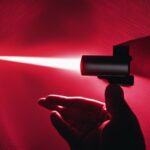When it comes to eye protection, near infrared (NIR) light is often overlooked. But is this light actually damaging to our eyes? In this article, we’ll explore the potential hazards of NIR light and what safety measures you can take to protect your vision. So if you’re wondering if NIR light can damage your eyes, read on to find out.
However, it is important to keep in mind that some everyday activities such as welding and laser surgery use near infrared radiation. If precautions are not taken, people can be exposed to hazardous levels of NIR radiation. It is important to use protective eyewear when working with near infrared radiation.

Contents
What is Near Infrared Light?
Near Infrared Light (NIR) is a type of electromagnetic radiation that falls just below visible light on the electromagnetic spectrum. It has a longer wavelength than visible light, making it invisible to the human eye. NIR is used in many everyday applications from medical diagnostics to infrared cameras and night vision goggles.
NIR is also used in a variety of industrial processes, such as welding and soldering. Despite its many uses, there is still some debate over whether or not NIR can be harmful to our eyes. In this article, we will explore the potential risks associated with NIR and discuss ways to protect your eyes from its potential effects.
How Can Near Infrared Light Affect Your Eyes?
Near Infrared Light has the potential to cause damage to the eye due to its high energy. This energy can cause the lens to heat up, leading to local tissue damage and possible vision loss. Additionally, long-term exposure to NIR has been linked to the development of cataracts, macular degeneration, and other eye diseases.
The amount of damage that NIR can cause to the eye depends on several factors, such as the intensity and duration of the exposure. In general, the higher the intensity and the longer the exposure, the greater the risk to the eye. It is important to note that short-term exposure to NIR is unlikely to cause any lasting damage.
How to Protect Your Eyes from Near Infrared Light
There are several steps you can take to protect your eyes from the potential risks associated with Near Infrared Light. The most important step is to avoid prolonged exposure to NIR. If you are working in an environment where you are exposed to NIR, it is important to take frequent breaks and wear protective eyewear.
It is also important to make sure that your protective eyewear is rated for the type of NIR you are exposed to. Many types of eyewear, such as safety glasses, are not effective against NIR. Specialized eyewear, such as welding goggles, are designed to protect against NIR and should always be worn when working with NIR sources.
What Are the Benefits of Near Infrared Light?
Although there are potential risks associated with Near Infrared Light, there are also many benefits that make it a valuable tool. NIR has a wide range of applications, from medical diagnostics to industrial processes. It is also used in night vision goggles and infrared cameras, which can be used for surveillance and law enforcement.
NIR has also been used in a variety of medical treatments, such as photodynamic therapy and photobiomodulation. These treatments use NIR to target specific cells and tissues, allowing for targeted treatment of diseases and injuries.
Conclusion
Near Infrared Light has many uses, but it can also pose a risk to the eyes if not used properly. It is important to be aware of the potential risks and take steps to protect your eyes from NIR. By taking the necessary precautions, you can help ensure that you and your eyes stay safe.
Frequently Asked Questions
Question 1: What is near infrared light?
Answer: Near Infrared light is a type of electromagnetic radiation that is just outside the visible spectrum of light. It has a wavelength that is slightly longer than visible light, and it is invisible to the human eye. Near Infrared light is often used in medical imaging, night vision, and other applications.
Question 2: Can near infrared light damage your eyes?
Answer: Generally, near infrared light does not cause any damage to the eyes. However, if the intensity of the light is very high, it can cause temporary discomfort or even damage to the eyes. Intense near infrared light can cause photokeratitis, or “welder’s flash,” which is a form of temporary blindness. It is important to be aware of the intensity of near infrared light when working with it.
Question 3: What are the symptoms of near infrared light damage?
Answer: The symptoms of near infrared light damage can include redness and pain in the eyes, as well as temporary blindness. If the exposure to near infrared light is severe enough, it can cause permanent vision damage. It is important to seek medical attention if you experience any symptoms of near infrared light damage.
Question 4: What precautions should be taken when working with near infrared light?
Answer: When working with near infrared light, it is important to wear protective goggles and to ensure that the light is not too intense. It is also important to take breaks from viewing the light and to never look directly at the light source. Additionally, it is important to be aware of the level of near infrared light that is being used and to avoid overexposure.
Question 5: Are near infrared light safety measures regulated?
Answer: Yes, safety measures related to near infrared light are regulated. Government agencies such as the Occupational Safety and Health Administration (OSHA) have set limits on the amount of near infrared light that can be safely exposed to without protective equipment. Additionally, some states have enacted their own regulations regarding near infrared light safety.
Question 6: What are the benefits of using near infrared light?
Answer: Near infrared light has many practical applications. It can be used in medical imaging to diagnose medical conditions, and it can be used in night vision devices to see in low light environments. Near infrared light can also be used in security systems to detect motion, and it is used in some types of laser pointers. Additionally, near infrared light can be used to measure the temperature of certain objects.
Does Near Infrared Light Cause Cataracts? Eye safety and protection for Red Light Therapy.
In conclusion, Near Infrared Light can be potentially damaging to the eyes. While there is still some debate about the effects of these types of light on our eyes, it is still best to be cautious and protect your eyes from excessive exposure. Wearing safety glasses or goggles when working with tools that emit Near Infrared Light is a good way to ensure that your eyes remain safe. Taking additional precautions and consulting with a doctor or optometrist if you experience any symptoms of eye strain or discomfort while working with Near Infrared Light can also help to ensure the safety of your eyes.








